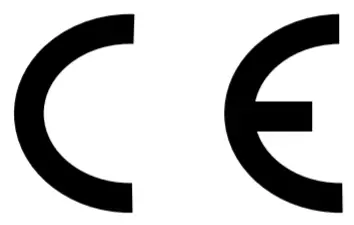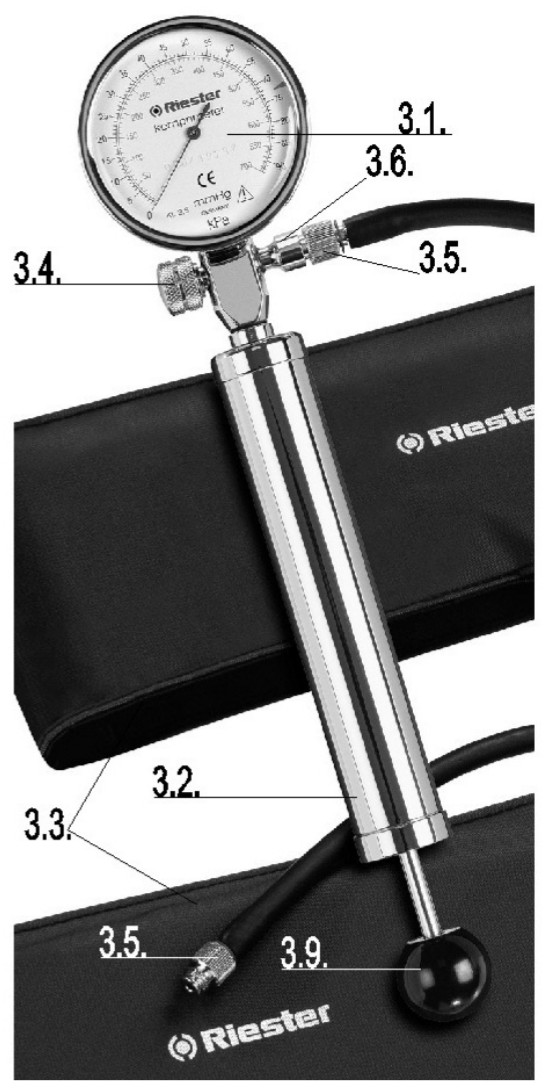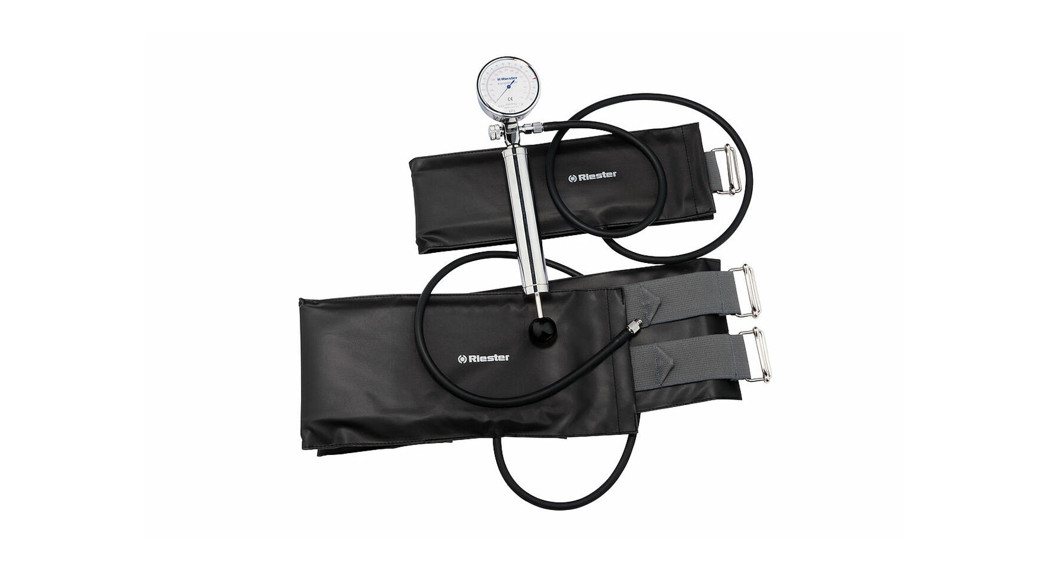 komprimeterInstructionsPneumatic tourniquet
komprimeterInstructionsPneumatic tourniquet




Important information – read prior to start-up
You have acquired a valuable RIESTER product manufactured in compliance with Directive 93/42/EEC for medical products and subject to continuous stringent quality control.Should you have any queries, please contact the Company or your RIESTER Agent who will be pleased to assist you. For addresses see the last page of these Operating Instructions. The address of your authorized RIESTER Agent will be supplied to you on request.Please note that any products described in these Operating Instructions are only suited for application by trained operators.Please also note that the correct and safe operation of products will only be guaranteed when RIESTER products and accessories are used throughout.![]()
![]()
![]()
![]()
Warning:Never connect the pneumatic tourniquet to pressure-generating equipment
Purpose
The RIESTER pneumatic tourniquet was designed for restricting the blood circulation to limbs in case of amputations.
Components (see figure)
| 3.1. Manometer3.2. Pump3.3. Cuff | 3.4. Release valve3.5. Tube connection part I (male)3.6. Tube connection part II (female) |
Operation of the unit
- Close the release valve (3.4.) by turning it clockwise
- Screw tube connector at the end of the cuff tube into the tube socket on the manometer housing.
- The pneumatic tourniquet with cuff must be checked before each application by trained staff or a physician on function and density.
Applying the cuff
Place the cuff around the respective limb and tighten the straps on the cuff by pulling them through the metal buckles. The tube exit should be approx. in the centre of the limb to be treated.
Replacement of bladder
Remove the bladder from the side opening of the cuff and insert the new bladder through the opening. Pull the tube through the opening on the long side of the cuff.
Operating the pump
Hold the pump (3.2.) in one hand and, using the other hand, carefully pull the air pipe of the pump on the black plastic ball (3.9.) up to the stop and then push it back into the valve. Repeat the pumping action until the manometer scale shows the desired value.
Restricting the blood circulation to the limbs
- Restricting the blood circulation to the armsIn order to restrict the blood circulation to the arms, the manometer must be pumped up to approx. 250 mmHg, using the pump.
- Restricting the blood circulation to the legsIn order to restrict the blood circulation to the legs, the manometer must be pumped up to approx. 550 mm Hg with the pump.
- Pressure controlThe adjusted pressure which the manometer shows must be continuously supervised by a responsible physician during the application and, if necessary, be corrected by after-pumps.
Letting out the air from the cuff after use
Open the deflating valve (3.4.). The air can now escape from the cuff and the cuff can be removed.
Cleaning
Cleaning and/or disinfectingManometerThe external surfaces of the pneumatic tourniquet can be cleaned with a moist cloth and can be disinfected with the following disinfecting agents: aldehyde, (formaldehyde, glutaraldehyde, aldehyde separators), tensides or alcohol. When using any of these substances, the instructions supplied by the manufacturer must be observed.CuffsAccording to current recommendations (Test Centre for Medical Products, Tübingen), the cuff covers should be thoroughly disinfected by wipe disinfecting with water-based disinfecting agents and with concentrations and influence times specified in the DGHM certificate and/or the DGHM list. Any residual disinfecting agent should be removed with tap water. The cuff covers should then be dried naturally.Caution!The cuff may not be ironed!Never expose cuff to intense sunlight!Avoid bringing the cuff cover, bladder or tubes into contact with sharp objects!SterilisationAccording to current recommendations (Test Centre for Medical Products, Tübingen), sterilisation is only required in case of operative procedures.11. Spare parts
| No. 11221 ManometerNo. 11220 PumpNo. 11222 Upper arm cuff with bladderNo. 11227 Cuff cover for upper arm bladderNo. 11224 Pad for upper arm cuff | No. 11219 Children’s cuff with bladderNo. 11229 Cuff cover for children’s cuffNo. 11246 Pad for children’s cuffNo. 11223 Thigh cuff with bladderNo. 11228 Cover for thigh cuffNo. 11225 Pad for thigh cuff |
Maintenance/accuracy test
The pneumatic tourniquet and its accessories do not require any special maintenance.For the accuracy test, remove the tube from the manometer and hold the manometer in a vertical position. If the pointer points to the zero position on the scale, the unit has been set up correctly. If the pointer does not point to the zero position, please return the unit to us or your local authorised RIESTER agent, whose details are available from us.



|
|
Detailed descriptions of the products can be found in the respective sections of the omnibus edition catalog (OrderNo. 51232-50).Or online under www.riester.de.
![]()
![]()
komprimeter
[xyz-ips snippet=”download-snippet”]

